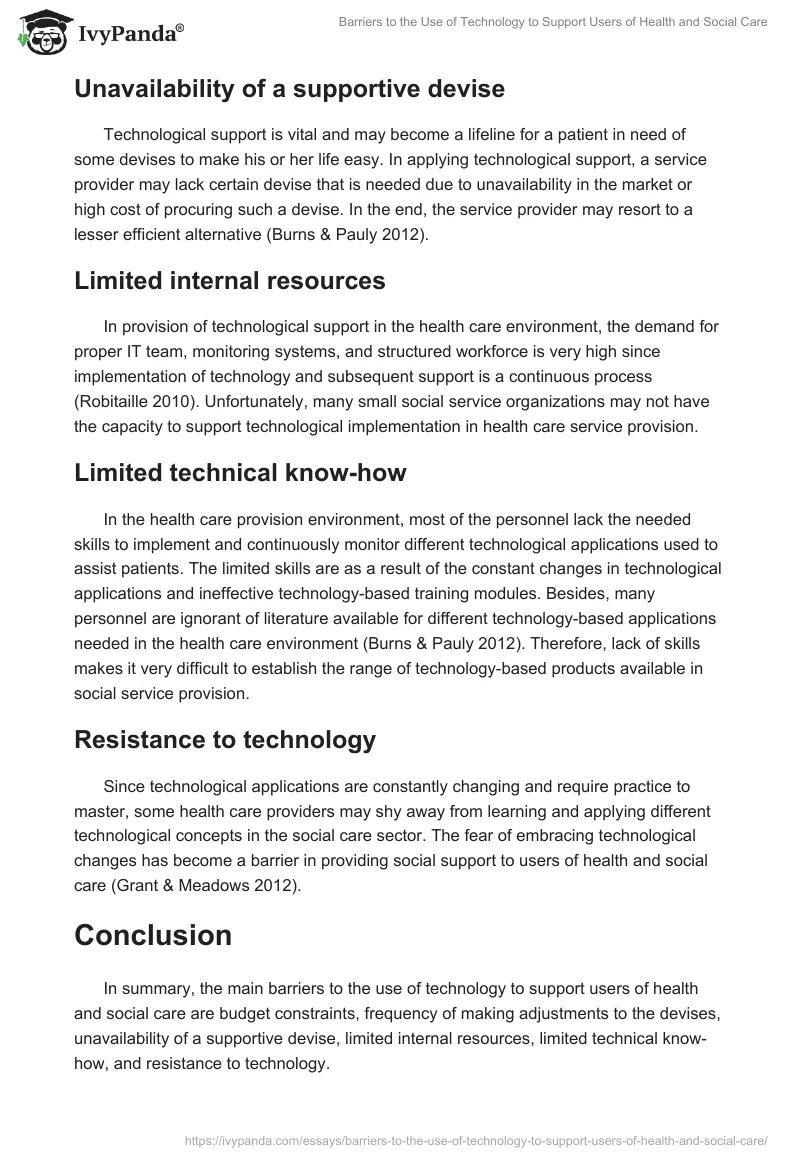Introduction
The use of technology to support users of health and social care has grown over the years due to a series of benefits such as making life easy for the user, boosting self-esteem, guaranteeing active daily life, and eliminating several discomforts. However, there are several barriers in the use of technology to support the users of health and social care such as budget constraints, frequency of making adjustments to the devices, unavailability of a supportive device, limited internal resources, limited technical know-how, and resistance to technology. This treatise discusses these barriers about the case study, Supporting Independent Living.
Barrier to the Use of Technology
Budget constraints
In most of the social care environments within the health care sector, the providers often operate within inflexible budgets that may not accommodate the cost of most the technologies needed. Besides, the patients may not be able to afford some of the devises needed (Scherer & Stefano 2012). In the case of Sally, she may need financial assistance to sustain the technological support as the devises become ore advanced and expensive.
Frequency of making adjustments to the devises
In application of technological support, the recommended devises may need adjustments and changes depending on observation reports. Constant adjustments may react negatively to some patients and social care supporters (Scherer & Stefano 2012). For instance, in the case of Sally, she has undergone series of adjustments in driving skills, typing, vision, and stability. In the long term, she may start getting very uncomfortable when the situation worsens.
Unavailability of a supportive devise
Technological support is vital and may become a lifeline for a patient in need of some devises to make his or her life easy. In applying technological support, a service provider may lack certain devise that is needed due to unavailability in the market or high cost of procuring such a devise. In the end, the service provider may resort to a lesser efficient alternative (Burns & Pauly 2012).
Limited internal resources
In provision of technological support in the health care environment, the demand for proper IT team, monitoring systems, and structured workforce is very high since implementation of technology and subsequent support is a continuous process (Robitaille 2010). Unfortunately, many small social service organizations may not have the capacity to support technological implementation in health care service provision.
Limited technical know-how
In the health care provision environment, most of the personnel lack the needed skills to implement and continuously monitor different technological applications used to assist patients. The limited skills are as a result of the constant changes in technological applications and ineffective technology-based training modules. Besides, many personnel are ignorant of literature available for different technology-based applications needed in the health care environment (Burns & Pauly 2012). Therefore, lack of skills makes it very difficult to establish the range of technology-based products available in social service provision.
Resistance to technology
Since technological applications are constantly changing and require practice to master, some health care providers may shy away from learning and applying different technological concepts in the social care sector. The fear of embracing technological changes has become a barrier in providing social support to users of health and social care (Grant & Meadows 2012).
Conclusion
In summary, the main barriers to the use of technology to support users of health and social care are budget constraints, frequency of making adjustments to the devises, unavailability of a supportive devise, limited internal resources, limited technical know-how, and resistance to technology.
References
Burns, R., & Pauly, M 2012, “Accountable care organizations may have difficulty avoiding the failures of integrated delivery networks”. Health Affairs, vol. 31 no. 11, pp. 2407-2416.
Grant, E, & Meadows, H 2012, Communication technology update and fundamentals, Taylor and Francis Group, New York.
Robitaille, S 2010, The illustrated guide to assistive technology and devices: Tools and gadgets for living independently, Cengage Learning, London.
Scherer, M 2007, Assistive technology: Matching device and consumer for successful rehabilitation, American Psychological Association, New York.
Scherer, M, & Stefano, F 2012, Assistive technology assessment handbook, CRC Press, London.


